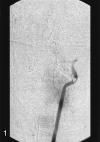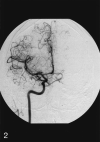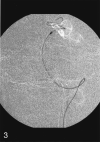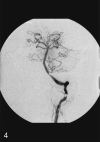Treatment of vertebrobasilar occlusion by using a coronary waterjet thrombectomy device: a pilot study
- PMID: 15956504
- PMCID: PMC8149074
Treatment of vertebrobasilar occlusion by using a coronary waterjet thrombectomy device: a pilot study
Abstract
Background and purpose: Despite improved patient outcomes because of intraarterial fibrinolysis, vertebrobasilar thromboembolism remains a fatal disease with a death rate of more than 50%. The outcome depends on the success of recanalization. Fibrinolysis achieves recanalization in only 50%-70% of the cases. Therefore, we investigated the feasibility of using a coronary mechanical device to increase the recanalization rate.
Methods: Twelve patients with acute vertebrobasilar occlusion were included in the pilot study. The older 5F and the new 4F versions of the Possis Angiojet catheter, which use a waterjet to attract, fragment, and extract the thrombus, were used. Inclusion depended on the presence of acute multisegmental intracranial or any extracranial vertebrobasilar occlusion. Exclusion criteria included coma lasting >8 hours and age >80. The Angiojet treatment did not exclude other therapeutic options.
Results: The Angiojet catheter accessed the thrombosed site in 10 of 12 patients. Combined treatment with the Angiojet and additional fibrinolysis or angioplasty resulted in a recanalization rate of 100%. Of 37 occluded vertebrobasilar segments, 30 were primarily recanalized with the Angiojet. Three symptomatic and two asymptomatic hemorrhages were detected by CT. Five of the 12 patients died. Fifty percent of all patients obtained a moderate to excellent outcome (Modified Rankin Scale 0-3).
Conclusions: Use of the coronary Angiojet in the vertebrobasilar system is feasible. The device has the potential to increase the recanalization rate, especially in cases of extensive thrombosis, and, thus, improve patient outcomes.
Figures






Similar articles
-
Aggressive therapy with intravenous abciximab and intra-arterial rtPA and additional PTA/stenting improves clinical outcome in acute vertebrobasilar occlusion: combined local fibrinolysis and intravenous abciximab in acute vertebrobasilar stroke treatment (FAST): results of a multicenter study.Stroke. 2005 Jun;36(6):1160-5. doi: 10.1161/01.STR.0000165918.80812.1e. Epub 2005 May 12. Stroke. 2005. PMID: 15890988
-
Endovascular Mechanical Thrombectomy with the Solitaire Device for the Treatment of Acute Basilar Artery Occlusion.World Neurosurg. 2016 May;89:301-8. doi: 10.1016/j.wneu.2016.02.017. Epub 2016 Feb 12. World Neurosurg. 2016. PMID: 26875658
-
Emergent revascularization of acute tandem vertebrobasilar occlusions: Endovascular approaches and technical considerations-Confirming the role of vertebral artery ostium stenosis as a cause of vertebrobasilar stroke.J Clin Neurosci. 2016 Dec;34:70-76. doi: 10.1016/j.jocn.2016.05.005. Epub 2016 Aug 10. J Clin Neurosci. 2016. PMID: 27522497
-
Stent Retriever Thrombectomy Potentially Increases the Recanalization Rate, Improves Clinical Outcome, and Decreases Mortality in Acute Basilar Occlusion: A Systematic Review and Meta-Analysis.Cerebrovasc Dis Extra. 2019;9(2):46-56. doi: 10.1159/000499665. Epub 2019 Jun 5. Cerebrovasc Dis Extra. 2019. PMID: 31167189 Free PMC article.
-
Endovascular revascularisation of acute tandem vertebrobasilar artery occlusion: seven case series with literature reviews.Stroke Vasc Neurol. 2018 Jan 24;3(1):17-21. doi: 10.1136/svn-2017-000125. eCollection 2018 Mar. Stroke Vasc Neurol. 2018. PMID: 29600003 Free PMC article. Review.
Cited by
-
Comparison of stent-retriever devices versus the Merci retriever for endovascular treatment of acute stroke.AJNR Am J Neuroradiol. 2013 Feb;34(2):366-72. doi: 10.3174/ajnr.A3195. Epub 2012 Jul 12. AJNR Am J Neuroradiol. 2013. PMID: 22790249 Free PMC article. Clinical Trial.
-
[Management of acute basilar artery occlusion].Radiologe. 2007 Apr;47(4):355-8. doi: 10.1007/s00117-007-1493-9. Radiologe. 2007. PMID: 17390121 Review. German.
-
Mechanical thrombectomy with stent retrievers in acute basilar artery occlusion.AJNR Am J Neuroradiol. 2014 May;35(5):959-64. doi: 10.3174/ajnr.A3796. Epub 2013 Nov 28. AJNR Am J Neuroradiol. 2014. PMID: 24287087 Free PMC article. Clinical Trial.
-
Endovascular recanalization of acute intracranial vertebrobasilar artery occlusion using local fibrinolysis and additional balloon angioplasty.Neuroradiology. 2010 May;52(5):361-70. doi: 10.1007/s00234-010-0658-9. Epub 2010 Jan 30. Neuroradiology. 2010. PMID: 20119683
-
Stroke attributable to acute basilar occlusion.Curr Treat Options Neurol. 2007 Mar;9(2):126-35. doi: 10.1007/s11940-007-0038-x. Curr Treat Options Neurol. 2007. PMID: 17298773
References
-
- Archer CR, Horenstein S. Basilar artery occlusion. Stroke 1977;8:383–390 - PubMed
-
- Hacke W, Zeumer H, Ferbert A, et al. Intra-arterial thrombolytic therapy improves outcome in patients with acute vertebrobasilar occlusive disease. Stroke 1988;1910:1216–1222 - PubMed
-
- Kunze I, Glahn J, Busse O. Heparin therapy in embolic cerebral infarct: a retrospective study. Nervenarzt 1991;628:477–482 - PubMed
-
- Bockenheimer S, Reinhuber F, Mohs C. Intraarterielle Thrombolyse hirnversorgender Gefäβe. Radiologe 1991;31:210–215 - PubMed
-
- Zeumer H, Freitag HJ, Zanella F, et al. Local intraarterial fibrinolytic therapy in patients with stroke: urokinase versus recombinant tissue plasminogen activator (rTPA). Neuroradiology 1993;35:159–162 - PubMed
MeSH terms
LinkOut - more resources
Full Text Sources
